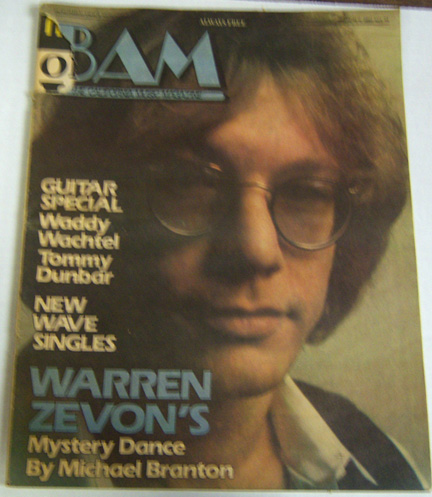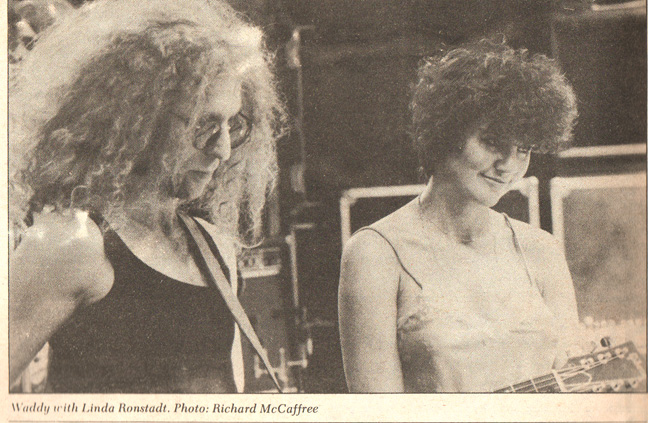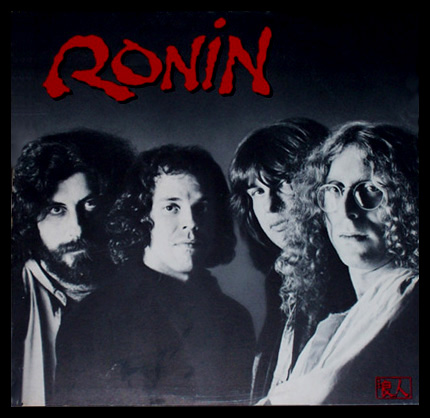 |
 |
 |
 |
 |
 |
 |
 |
/ Credits / Gigs / Songs |
/ Interviews |
/ Videos |
Wachtel Band |
List |
 |
 |
 |
 |
 |
 |
 |
 |
/ Credits / Gigs / Songs |
/ Interviews |
/ Videos |
Wachtel Band |
List |
|
Waddy Wachtel |
 |
 |
|
1980 Article and Interview from Bam Magazine Publication: Bam, The California Music Magazine Vol. 5, No. 74, Page 40 March 7, 1980 Waddy Wachtel: Confessions of a "Mafia" Guitarist By David Gans Waddy Wachtel, ace guitarist and member of Peter Asher’s “L.A. Mafia,” has just finished the most important recording sessions of his career—his own. Waddy and some of the players he’s worked with on all those great records have been waiting patiently for over two years until their schedules opened up enough that they could get together on their own. “We referred to ourselves casually as ‘the Boys,’” says Waddy, “but that name’s been taken now and we haven’t decided on a new one yet.” Once that minor detail is taken care of, the album will be released and a tour undertaken. The 32-year-old New York native has been in California for 11 years, during which time he has recorded and toured with Carole King, the Everly Brothers, James Taylor, Linda Ronstadt, Karla Bonoff, Andrew Gold, Randy Newman, J.D. Souther and Rod Stewart to name a few. Waddy co-produced Warren Zevon’s Excitable Boy with Jackson Browne, and Bryan Ferry’s second album with drummer Rick Marotta, with whom Waddy started the new band. He seems to be a very patient man. “I started writing songs when I was about 16,” he says. “I sat in the basement smoking cigarettes and drinking ginger ale, writing a million songs.” But he didn’t do what millions of other young hopefuls do and run down to the Brill Building to get famous. “I took pride in my writing,” he says, “but I’ve never pushed it.” Nevertheless, four years after he wrote it, Waddy’s “Maybe I’m Right,” which he calls “my first serious love song,” appeared on Linda Ronstadt’s Simple Dreams. Waddy also supplied most of the material for his new band along with Dan Dugmore, the guitarist Waddy calls “Mr. Pitch” because “he plays the most in-tune pedal steel in the world.” Waddy is careful to credit the people who have been kind to him through his career, and he expresses genuine admiration for the musicians he works with. When I asked him who he liked working with most, his unhesitating respose [sic] was, “my mates are the best.”  DG: So, when did it all start for you? WW: I started playing guitar when I was around nine or ten. I was practicing the “one-major” chord position on the fifth fret and accidentally ran down to the third fret, and it sounded like “Tequila.” That was the first time I learned a song by ear. DG: What guitar did you start out on? WW:It was a Kamico, one of the world’s most beautiful sights to a nine-year-old. My dad bought me a Gibson L-7 f-hole guitar when I was ten. I had it for years, but it got stolen a while back. Then when I was 11, I talked my uncle into buying me a Les Paul. I’ve played Les Pauls for the most part, but I’ve also become a Fender user. That started by accident when I was on the road and my Les Paul broke. I went and played a bunch of Les Pauls I didn’t like, and ended up buying a ’56 Stratocaster. Now I use it all the time. DG: What is your idea of the ‘ultimate’ guitar? WW: My Les Paul. It’s stock, 1958 or ’59, with the original sunburst finish. It’s got the greatest neck in the world. I buy a guitar by how the neck feels, and of course how it sounds. It so happens that the guitars I have are older. My youngest guitar is a ’64 Stratocaster. DG: Do you use a lot of different guitars and amps? WW: Not really. I own a Les Paul, two Strats, a Telecaster, a Gibson J-200 acoustic and a Gibson Super 400—that’s their top jazz F-hole model—and I have a Rickenbacker lap steel. I leave the Super 400 at home when I’m traveling, and I bring the acoustic along just to have in the room with me. My amplifier is a Music Man 210. DG: Do you use any effects? WW: Just a volume pedal. A really loud, trebly guitar can sound just like a fiddle if it’s pedaled in right. And I just bought an echoplex. I’m not technically oriented though—it took me a long time to figure out the “in” and “out” jacks on those MXR boxes. DG: What kind of strings do you use? WW: Fender rock and roll regulars. I think they start with .010 on top. DG: Who are the guitarists you’ve admired over the years? WW: I was a massive truant during school. I stayed home and learned from jazz records, players like Johnny Smith, Kenny Burrell, Charlie Byrd. Duane Eddy used to twist my brains around. I didn’t know about blues and rock until the British invasion. I really liked The Yardbirds, Eric Clapton, Jimmy Page, Jeff Beck, Peter Townshend. Jimmy Page astounds me with how he approaches a solo. A lot of his ideas seem to come from left field, and a lot of times he plays too damn many notes, but there is a real brilliance in his music. And his arrangements are great. In addition to those other guys, Keith Richards I just love to death. The way he plays rhythm kills me — his accompaniment concept is amazing, plus he invented some of the great rock and roll signature lines of all time. But it’s Jimi Jendrix above all the others. That guy was too much. He could completely baffle me. His arrangements were extremely well-constructed, perfect settings for his guitar work. I had a book when I was a teenager, called Mickey Baker’s How To Play Jazz Guitar. There was a page in there on improvising, how to develop your “soul.” That word—soul—is what playing music is all about. And the book said that everybody learns by copying the things they love, so I learned all the solos—just played and played and played. DG: How did you get started in session work? WW: I came to Los Angeles with a band and ideas of making it. Without going into details, the manager was fucking us around, and I ended up quitting the band to try and become a session player. A guy I knew hired me for a session, and Sneeky Pete was playing. He’s a guy I’ve admired a lot, and when he complimented me, it was a real boost. And I got hired again. Then someone brought me to one of Nick Venet’s sessions, and he liked me and hired me again. I worked with Nick for a number of sessions, and then one time he said, “It’s time to move on, Waddy.” I didn’t know what he meant, and it worried me. He brought David Foster to that session to hear me play, and Foster recommended me to Lou Adler for Carole King. Nick was telling me it was time to expand, to move up a notch. I did Thoroughbred with Carole, and I toured it, too. DG: It sounds like a combination of good skills and good luck. What do you think makes a good session player? WW: The most important characteristics of a studio musician are quickness, accuracy and consistency. You don’t get much time to figure out what to play, and you have to play it the way someone wants to hear it—and you have to do it right the first time and maybe play it the same way a couple more times. DG: It seems like a good personality is nearly as important as good chops when you’re doing studio work. WW: You can’t really separate them. Without the chops, you wouldn’t be there, but if there were two guys of approximately the same skills, and one of them was a prick, you’d know who to choose, right? DG: Tell me about your favorite recording session. WW: I’d have to say it was Linda’s recording of “Poor Poor Pitiful Me,” which we recorded on my birthday. We got a really good take on the first try—Linda’s vocal, the guitar solo and everything were all done at once—but we decided to do another take anyway. That second one was just balls, man, a motherfucker. Rick Marotta said, “That was the most exciting thing I’ve ever played in the studio.” That was when Rick and I decided to put a band together. Randy Newman was great to work with, too. He’s brilliant and sarcastic, and we got along just great. Randy is unbelievable. DG: Do you do most of your playing on overdubs or in ensemble? WW: Nowadays I play lead right on the basics most of the time, because people know I can do it well and they hire me to come in and blow. DG: And now you’re playing on your own sessions. WW: I’m giving up a really comfortable lifestyle to do it—it’s “put your ass on the line” time. But these are the best players in the world, and we’ve got the best management in the world. We’re ready to hit the road.  | Modern Recording and Music | Guitar World | Guitar Player | International Musician | Musician | Misc. Articles | Waddy Wachtel Interview Part 1 | Waddy Wachtel Interview Part 2 | Nina 1 | The Record | Bam Magazine | WW Book References | Keith Richards Life | L.A. Magazine | Soundcheck | Rolling Stone Magazine 4/11/13 | Burst Believers | WW Interview by Joe Bosso | WWGibsonInterview11/28/14 | WaddyWachtelInterview12/18/14 | | Return Home | Discography / Credits / Gigs / Songs | Articles / Interviews | Photos / Videos | Contact | Waddy Wachtel Band | Search | Mailing List | |
||
 |
 |
